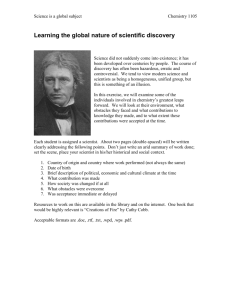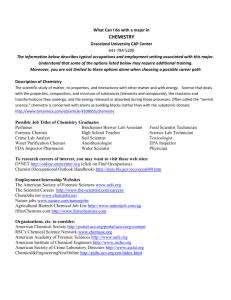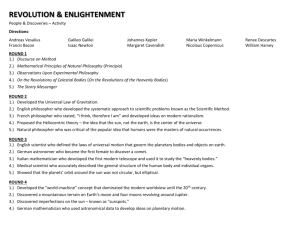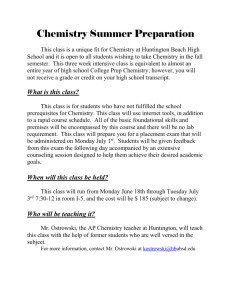File
advertisement
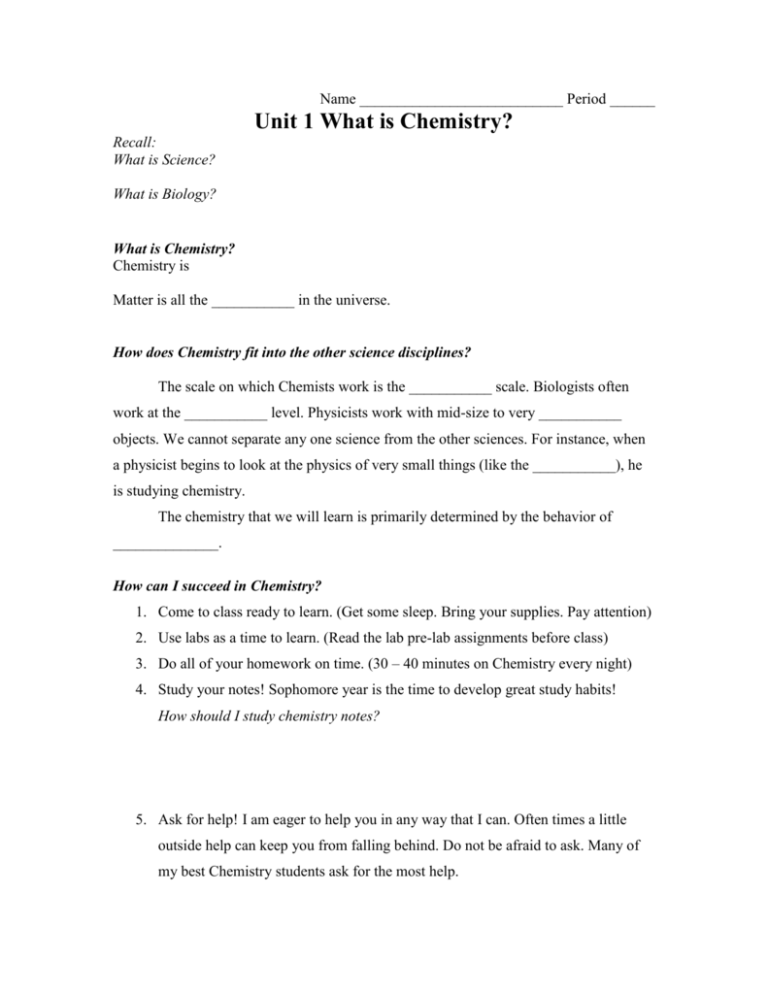
Name ___________________________ Period ______ Unit 1 What is Chemistry? Recall: What is Science? What is Biology? What is Chemistry? Chemistry is Matter is all the ___________ in the universe. How does Chemistry fit into the other science disciplines? The scale on which Chemists work is the ___________ scale. Biologists often work at the ___________ level. Physicists work with mid-size to very ___________ objects. We cannot separate any one science from the other sciences. For instance, when a physicist begins to look at the physics of very small things (like the ___________), he is studying chemistry. The chemistry that we will learn is primarily determined by the behavior of ______________. How can I succeed in Chemistry? 1. Come to class ready to learn. (Get some sleep. Bring your supplies. Pay attention) 2. Use labs as a time to learn. (Read the lab pre-lab assignments before class) 3. Do all of your homework on time. (30 – 40 minutes on Chemistry every night) 4. Study your notes! Sophomore year is the time to develop great study habits! How should I study chemistry notes? 5. Ask for help! I am eager to help you in any way that I can. Often times a little outside help can keep you from falling behind. Do not be afraid to ask. Many of my best Chemistry students ask for the most help. Why do we bother with Chemistry? 1. 2. a. f. b. g. c. h. d. i. e. j. 3. 4. One more study tip… The Scientific Method 1. ____________________ /____________________ a. Scientific method begins with a ________________ or a question, about which we form a ____________________, or an educated guess. 2. ____________________ a. Sometimes called an “___ ___________ –statement”. b. Should predict the outcome of the experiment. 3. ____________________ a. Ideally, a __________________ is used to eliminate all variables but one. b. The thing that is being varied in a controlled manner is the ____________________ ____________________. c. The thing that varies as a result of varying the independent variable is the ____________________ ____________________. 4. ____________________ Collection/organization a. Data is recorded and organized so that it can be studied and analyzed for patterns. b. Often ____________ and charts help guide a scientist to the conclusion that the data offers. c. When graphing data, the independent variable goes along the ___-axis and the dependent variable goes along the ___-axis. 5. ____________________ a. The conclusion should address the ____________________. Was the hypothesis correct or not correct? 6. New ____________________ /____________________ a. Often experiments raise new questions or point a scientist in a direction of further investigation. Graphing and Organizing Data Graphing Tips: 1. Start by using a _______________. When you finish, you may add _______________ -coding by tracing over the pencil lines. 2. Before you graph, your information must be recorded in a _________ _________. The chart should have the x’s on the _________ and the y’s on the ___________. 3. _______________ variable goes on the x-axis 4. _______________ variable goes on the y-axis 5. Determine the _______________ of each variable. (Subtract the lowest point from the highest point for each axis). 6. Arrange the scale such that the graph fills nearly the whole page. Chose intervals that divide easily into the divisions on the paper. For example, “every line is 10” is better than “every line is 13”. 7. Clearly _______________ the graph and label both axes. 8. Plot the _______________ using heavy dark marks. 9. Draw a _______________ best-fit line rather than rigid lines with sharp corners. Science or Superstition? Using your knowledge of the scientific method, create an experimental setup to test the validity of these sayings. Address the following questions in your experimental proposal. Use a separate sheet of paper. a. b. c. d. e. f. What is the independent variable? What is the control? What is the dependent variable? How will you measure the dependent variable? What sample size will you use? Describe the experiment. How will you isolate only one variable? 1. “An apple a day keeps the doctor away.” 2. “Eating chocolate causes zits.” 3. “When you shave, the hair grows back twice as thick.” 4. “Coffee stunts a child’s growth.” 5. “If you swim right after eating, you will get cramps.” 6. “Spit on a new bat before using it for the first time to make it lucky.” Discussion: 7. What affect does sample size have on the conclusion of an experiment? Where Science and Philosophy Meet “Faith and reason are like two wings on which the human spirit rises to the contemplation of truth; and God has placed in the human heart a desire to know the truth—in a word, to know himself—so that, by knowing and loving God, men and women may also come to the fullness of truth about themselves (cf. Ex 33:18; Ps 27:8-9; 63:2-3; Jn 14:8; 1 Jn 3:2).” -Pope John Paul II ENCYCLICAL LETTER FIDES ET RATIO The more we learn about the physical world –creation, the more our eyes are turned toward the creator. Prerequisites to Science 1. 2. 3. Scientists ask _______? And ______? Philosophers ask _____? And ________? For Example, science addresses the question, “What is alive and how does it function?” The philosopher wonders why is there something rather than nothing. Why is anything alive? Should we respect life? Scientific discoveries can lead to new technologies. A scientist can ask, “How can we harness the energy in the nucleus of a hydrogen atom?” The philosopher asks, “Should we use this technology to kill?” Science can make theories based on laws of nature. It does not touch the question of why nature operates on laws. Science is the study of the natural world. Any questions of the supernatural world are left to philosophers. In short, science can never hope to prove that God exists or does not exist. For each the following topics, write a question that a scientist would ask and another question that a philosopher could ask. 1. Cloning A scientist may ask, “ A philosopher may ask, “ 2. Medicine A scientist may ask, “ A philosopher may ask, “ 3. Weapon Technology A scientist may ask, “ A philosopher may ask, “ Think of another issue where science meets philosophy and do the same thing. Issue: A scientist may ask, “ A philosopher may ask, “ “What is this Stuff?” 1. Matter is anything that has _______ and occupies __________. There are four(ish) phases of matter: __________________, _________________, _________________, and __________. The changes between phases have names. a. Liquid to gas – d. Gas to solid – b. Liquid to solid – e. Solid to gas – c. Gas to liquid – f. Solid to liquid – 2. ____________________ are the distinguishing characteristics of a substance used in its identification and description. Properties fall into two categories. a. __________________ properties –can be observed _________________ ___________________ the substance into another substance. i. Examples b. ___________________ properties –how a substance _______________ or ________________ _________________ into a new substance i. Examples: 3. Another way to classify properties depends on whether the ________________ of substance changes the property. a. __________________ properties do not depend on the amount of substance present. i. Examples b. ________________ properties depend on the amount of substance present. i. Examples “What happens when I mix it together?” 4. Chemists study changes in matter. There are two types of changes. a. A ____________________ change changes the physical appearance of a substance without changing the identity of the substance. b. A ____________________ change alters the chemical composition of a substance, thus forming a _________ ______________. This process is called a chemical reaction. 5. Chemists are concerned with the make up of matter. All matter can be classified into two categories. a. Mixture – i. _________________________ –more than one visibly distinct part, each with separate properties. Examples: ii. _________________________ –only one visible part with uniform properties throughout. Examples: b. Pure substance – i. ______________________ –can be broken down further by _____________________ processes. Examples: ii. _____________________ –cannot be broken down further by chemical or physical processes. Examples: 6. Short-hand for Chemists: a. Each element has a ______________. i. Either just one ________________ letter, or one ______________ letter followed by one ______________ -case letter. ii. Example: C, N, Mn, Sn, b. ______________ ______________ tell us the make up of the smallest piece of a substance. i. Subscripts after the elemental symbols tell how many of those elements are present in each molecule. ii. A large numbers in front of a chemical formula refers to how much of the substance is present. iii. 5 CaCO3 Example: c. What’s the deal with symbols that do not match their name? i. They’re ________. These elements were identified during a time when ________________ was the main language of science. Therefore, their symbol matches their Latin name and not their English name. ii. Examples: The Latin name for iron is ferrum, which explains the symbol, Fe. The Latin name for gold is aurum, hence, Au. Elemental Symbols Know the symbols and the names of these elements. Given the symbol, write the name. Given the name, write the symbol. Spelling counts. H He Li B C N O Si Ne Hydrogen Helium Lithium Boron Carbon Nitrogen Oxygen Silicon Neon F Al Fe Ni Cu Zn Pb Hg Au Fluorine Aluminum Iron Nickel Copper Zinc Lead Mercury Gold Ag Sn Cl Na Mg K Ca Pt U Silver Tin Chlorine Sodium Magnesium Potassium Calcium Platinum Uranium
